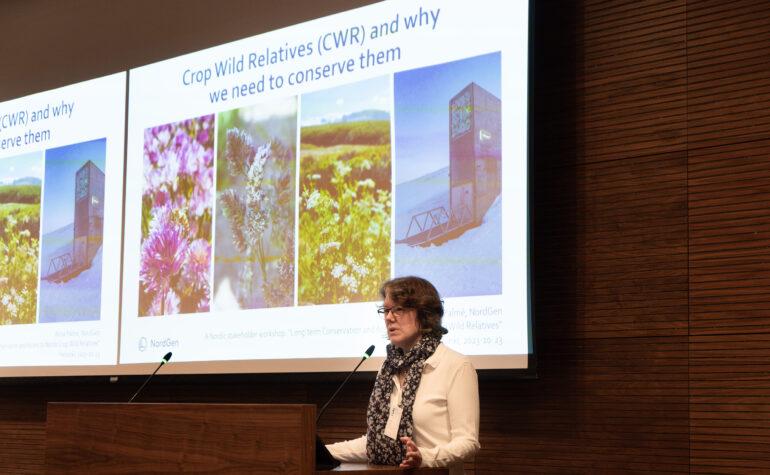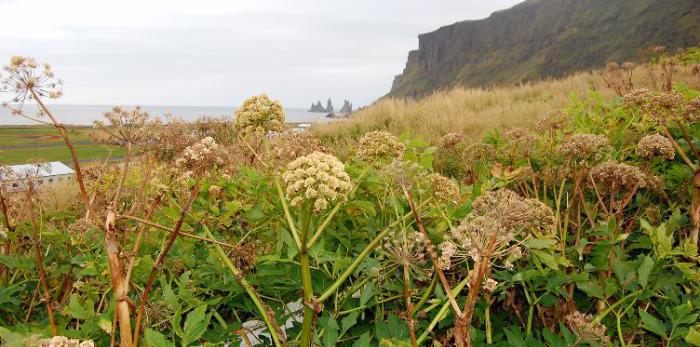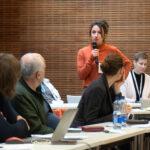Sweden
November 3, 2023
Last week, a stakeholder workshop was organized in Helsinki as part of NordGen’s project on Nordic crop wild relatives. The program included presentations about the significance of the wild plants in plant breeding and the importance of in situ-conservation. Conservation efforts are required – and it is urgent.
Climate change, biodiversity loss and an increased human population present society with major challenges, not least when it comes to our food security. The crop wild relatives (CWR, wild plant species closely related to our cultivated crops) carry traits that can be very important for developing new crops that are better adapted to a changing climate and better suited to drought, waterlogging or various forms of pests and diseases.
That’s why NordGen is coordinating a pan-Nordic CWR project. As part of this, a stakeholder workshop was organized last week in Helsinki to increase and share knowledge about these important wild plants. About 40 persons participated in the meeting that was held at the Ministry of Agriculture and Forestry of Finland. Representatives from research institutes, authorities, universities, and project participants from the Nordic countries attended the workshop. The program included presentations with several different themes as well as group discussions.
“CWR are one of the important tools that we can use to address food security in a changing climate, but they are at the same time becoming increasingly threatened in the wild. Actions to conserve them for future generations are therefore urgently needed,” said Anna Palmé, NordGen’s Senior Scientist on Nordic Crop Wild Relatives.
 Anna Palmé, NordGen’s Senior Scientist on Nordic Crop Wild Relatives.
Anna Palmé, NordGen’s Senior Scientist on Nordic Crop Wild Relatives.
Scenarios for 2100
The importance of urgent actions was something that the audience became aware of during a presentation by Heli Fitzgerald, Project Coordinator at the Finnish Museum of National History (LUOMUS). As part of the Nordic CWR project, she is working on climate change modeling that compares the current geographical distribution of prioritized CWR in the Nordic countries with two scenarios. The “Middle of the Road” scenario SSP245 means an estimated warming with 2.7 °C by 2100. In the even more troublesome scenario SSP585, the estimated warming will be 4.4 °C by 2100. The models suggest that many CWR species’ suitable habitats will decrease or shift north or to higher altitudes and some will not have suitable conditions within the region anymore by 2100, especially those with northern distributions. Angelica (Angelica archangelica) and Elymus kronokensis (a relative to wheat) are examples of species that will get a very hard time in both scenarios.
 Angelica archangelica in Icelandic nature. The top photo shows Icelandic Elymus kronokensis, photo by Magnus Göransson.
Angelica archangelica in Icelandic nature. The top photo shows Icelandic Elymus kronokensis, photo by Magnus Göransson.

Heli Fitzgerald.
“Therefore, recommendations for action will be needed. One example could be to monitor CWR populations and their habitats to observe changes and another to step up the seed collection efforts particularly from vulnerable, northern and mountainous areas of the region,” said Fitzgerald.
Since the CWR have adapted to the geographical area in which they grow, it is important to conserve them in their natural environment (in situ conservation). Conservation in genebanks (ex situ conservation) is on the other hand a backup option and a way to make the plants available for plant breeding and research. There are examples of CWR in situ reserves in Europe. During her presentation, Ada Stella Molina Pertíñez, researcher from Rey Juan Carlos University, talked about experiences from Spain. During 2019 to 2021, six pioneer genetic reserves for 38 CWR species were established in the Biosphere Reserve Sierra del Rincón, in the north of Madrid. To be successful in the long term, there are many factors to consider, for example when selecting the populations. Perhaps tenancy can be a risk for the long-term conservation? Or are there any management activities that might be a threat to the populations? Grazing at the wrong time in the life cycle of the plant or sports events may also need additional measures.

Ada Stella Molina Pertíñez.
“But in general, we think that the less we interfere the better. If they weren’t doing the management as they were doing maybe the CWR would not be there in the first place. To succeed over time, it is crucial to sustain a good contact with the network of stakeholders that are active in the area,” said Pertiñez.
Successful Examples
The participants also got to listen to the plant breeders’ perspective. In her presentation, Merja Veteläinen, Director for Plant Breeding of Boreal Plant Breeding, talked about the use of CWR in plant breeding of field crops, and forages in particular. For example, Boreal have had tall fescue breeding programs based on collected wild material from Finland. And two important timothy varieties were developed largely from collected material. One of these cultivars, “Tuure”, has the largest market share in Finland since 2014. The use of CWR in plant breeding is challenging, not least since it requires a lot of time and effort, but Veteläinen thinks that the wild relatives can be useful, also in the future.

Merja Veteläinen.
“We have good future prospects to enhance the use of CWR in breeding. Cooperation between genebanks and breeders leads to quicker adoption of new germplasm. Therefore, I would like to see more of targeted collection and evaluation projects in collaboration between genebanks and breeders,” said Merja Veteläinen.